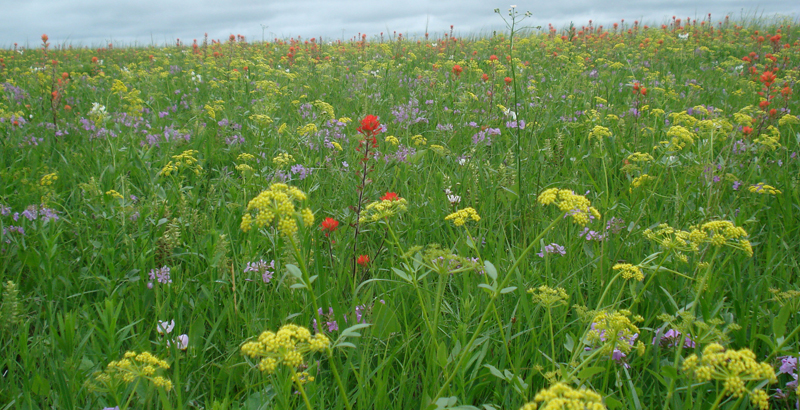
Diversity: Green in All Seasons

Tales of an old timer have it that the glades of the Ozarks (native grasslands growing where bedrock is at or near the soil surface), grew grass year-round for livestock and wildlife. The old timer continued that there was no need to feed hay in winter because there was always something green. How can this be when the native grasslands are so well known for their summer grass growth and profusion of wildflower blooms?
One of the famous grasses-of-summer is Big Bluestem. As I write this, a touch of snow still remains on the ground and all of the above-ground parts of the Big Bluestem are brown; it is not collecting any sunlight. It will show no signs of life until it sluggishly wakes up sometime in mid to late April. This grass is classified in a group called warm season grasses, and this group contains other well-known grasses of our grasslands (e.g. Indiangrass, Little Bluestem, Switchgrass, Eastern Gama Grass).
The answer to the old timer’s mystery however lies in the fact that there is another class of plants in addition to those grasses-of-summer, known as cool seasons. Take for instance a lesser-known species, Wild Ryes. Peeking out of the snow today is 3-4” of green growth that is actively collecting sunlight. Though it may not be measurably growing aboveground in the snow, it is growing new roots below ground and getting ready for the warmer weather when it will quickly take off and grow.
When warm season grasses and cool season grasses are present, the growing season can be extended from as little as one third of the year to three quarters of the year! This has obvious benefits to both wildlife and livestock: if there are actively growing plants, there is quality forage, and, if the plants are growing nearly year-round, there will be more to eat. In fact, a diversity of plants can produce over 200% more growth than a single high-producing species planted alone1.
From the perspective of folks who want to restore a rare and declining habitat (e.g. savanna, glade, prairie) or folks who want to landscape with native plants, there are also benefits to having plants that grow in each season. It reduces the weed competition (Mother Nature will put something there if you don’t), takes more carbon out of the air and puts it in the soil (adding carbon to the soil in the form of organic matter is a good thing for the soil and the plants growing in it), and makes for healthier soils (the microscopic creatures in the soil have a more steady food supply with a diversity of plants).
Diversity is as good as it gets!
1 The statement that diverse native grasslands can produce over 200% as much forage as a monoculture of Switchgrass is based on very interesting research by David Tilman and others and published in an article titled “Carbon-Negative Biofuels from Low-Input High-Diversity Grassland Biomass”, which is found in Science Volume 314 and published in 2006.


